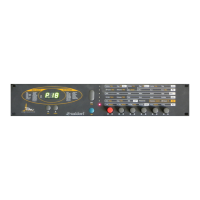User’s Manual Pulse • PulsePlus
17
7.4 The Store Function
After you have finished editing a program, you must save it if you intend to use it again. The
program memory locations 1 through 40 are available for this purpose.
☞ This is how you store a program:
• Press and hold the Shift key 햺 .
• Briefly press the Scroll key ▼ 햽. This Scroll key's alternate function is Store,
indicated in orange lettering.
• Release the Shift key 햺 .
• A flashing S. appears in front of the selected program number in the display:
The indicated memory location number will always be from 1 to 40, i.e. within the
range of the freely programmable memory locations. If you have edited a factory
preset program, it must be stored in one of these memory locations. The Pulse will
suggest a program number equivalent to the original number plus 40.
Original Program Suggested Program
1...40 1...40
41...80 1...40
81...99 1...19
P.rn 20
• If you want to store the program at a memory location other than the suggested
one, use the Scroll keys ▲ and ▼ to select the desired program number.
• Press and hold the Shift key 햺 and press the Store key 햽 again.
You have now stored the program.
When you activate the Store function, Edit or Compare modes are terminated.
By pressing the Mode key 햶 , you can terminate the process at any time before you
press the Store key 햽 for the final time.
Example: Program 9 is the selected
memory location

